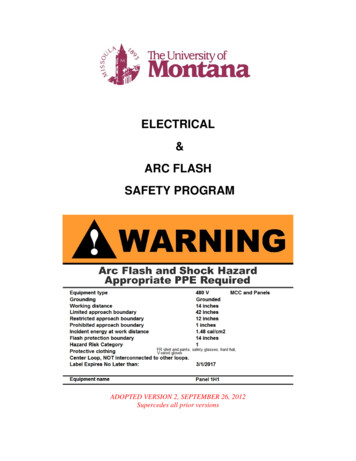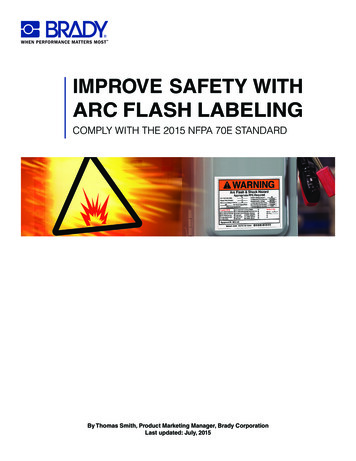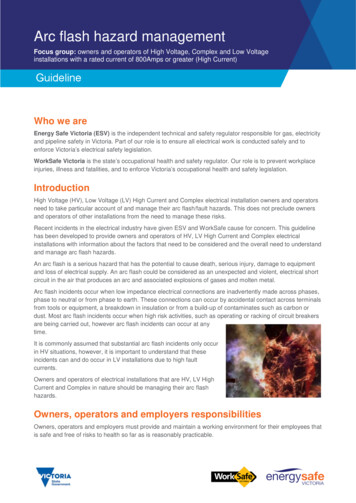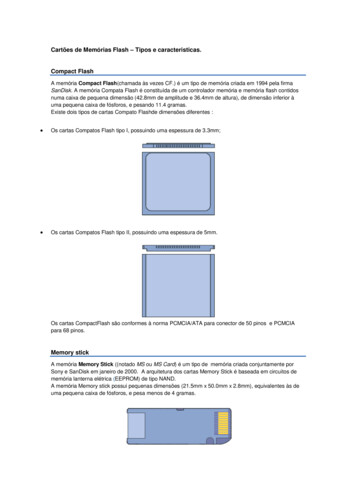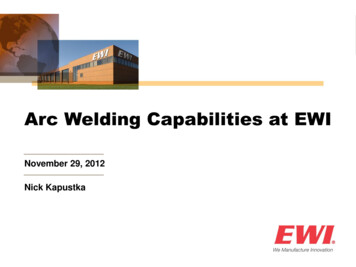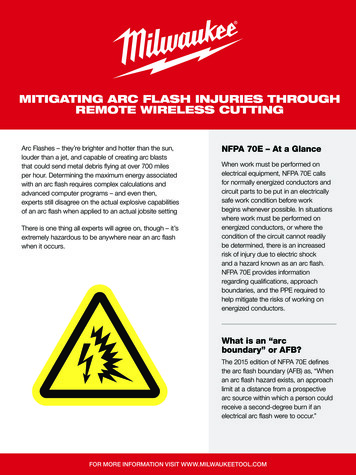
Transcription
MITIGATING ARC FLASH INJURIES THROUGHREMOTE WIRELESS CUTTINGArc Flashes – they’re brighter and hotter than the sun,louder than a jet, and capable of creating arc blaststhat could send metal debris flying at over 700 milesper hour. Determining the maximum energy associatedwith an arc flash requires complex calculations andadvanced computer programs – and even then,experts still disagree on the actual explosive capabilitiesof an arc flash when applied to an actual jobsite settingThere is one thing all experts will agree on, though – it’sextremely hazardous to be anywhere near an arc flashwhen it occurs.NFPA 70E – At a GlanceWhen work must be performed onelectrical equipment, NFPA 70E callsfor normally energized conductors andcircuit parts to be put in an electricallysafe work condition before workbegins whenever possible. In situationswhere work must be performed onenergized conductors, or where thecondition of the circuit cannot readilybe determined, there is an increasedrisk of injury due to electric shockand a hazard known as an arc flash.NFPA 70E provides informationregarding qualifications, approachboundaries, and the PPE required tohelp mitigate the risks of working onenergized conductors.What is an “arcboundary” or AFB?The 2015 edition of NFPA 70E definesthe arc flash boundary (AFB) as, “Whenan arc flash hazard exists, an approachlimit at a distance from a prospectivearc source within which a person couldreceive a second-degree burn if anelectrical arc flash were to occur.”FOR MORE INFORMATION VISIT WWW.MILWAUKEETOOL.COM
Electric arcing can produce temperatures as high as 35,000 F –nearly four times as hot as the surface of the sun. Even though thisintense heat can last for just a fraction of a second, it’s enough timeto cause severe burns, potential hearing loss, blindness, skin damagefrom blasts of molten metal and copper, lung damage and blastinjuries from shrapnel, and even death.Arc Flash35,000 FAll of this is why the Occupational Safety and Health Administration(OSHA ), the Institute of Electrical and Electronics Engineers (IEEE),and the National Fire Protection Association have drawn up threemajor industry standards associated with arc flash:nOSHA 29 Code of Federal Regulations Part 1910 Subpart SnNFPA 70EnEEE Standard 1584NFPA 70E in particular has been influential in directing safety relatedpractices and maintenance requirements for jobsites that have thepotential of arc flash incidents.But despite the effectiveness of these requirements, there remainsthe unfortunate fact that arc flash is unpredictable. In a report by theIEEE, the organization stated, “Workers and equipment may be atrisk from electrical arc, even at times when codes, standards, andprocedures are seemingly adequately addressed” and that “workersshould ‘assume the worst’ and use available personal protectiveequipment.” Simply put – the unpredictable nature of arc flashaccidents is why it is so important to know about them and stayaway from dangerous situations.Sun10,000 FArc Welding3,000 FARC FLASH INJURIESBurnInjuries fromrelease ofmolten materialsDamage tohearing andeyesightFOR MORE INFORMATION VISIT WWW.MILWAUKEETOOL.COMDeath
The Impact on Your Crew & CompanyAccording to OSHA standards, an arc flash incident only needs to be reported if (A) A fatality occurs or(B) Three or more employees require hospitalization. With that in mind, it’s not a stretch to assume that currentdata does not capture the full landscape of arc flash risks and incidents occurring each day. This inconsistentreporting practice has led to a wealth of conflicting data on the frequency of arc flash accidents, with figuresranging from 5 – 10 per day to 30,000 per year. These reports also estimate that those incidents result in anaverage annual total of 7,000 burn injuries, 2,000 hospitalizations, and 400 fatalities per year. In fact, accordingto the Bureau of Labor Statistics about 80% of these incidents involve “qualified workers,” showing that eventrained experts can get hurt – another reminder of the unpredictable nature of arc flash.The direct monetary costs to your injured crew member and the indirect monetary costsfor your company? They’re numerous.Direct Monetary Costs – Includes medical treatment and rehabilitation, workers compensation,cost of accident investigation, and downtime/loss of production.1.5 DAYS19 DAYS8-1261K of hospitalization for EVERY PERCENTof the body that is burnedis the average hospitalizationresulting from an arc flash eventis the average amount of months neededfor a worker to return, if injured by an arc flashis the average an employee canreceive for workers compensationIndirect Monetary Costs – Such as legal costs and judgments related to litigation, potential fines, increasedinsurance premiums, repair costs, and the cost of replacement workers.10.5M 10K OR JAIL is the average litigation cost to defendantsfor a general industry incidentcan become the penalty for an employee death resultingin failure to comply with OSHA regulationsFOR MORE INFORMATION VISIT WWW.MILWAUKEETOOL.COM
The Safest Solution – Cutting Conductors from a DistanceWith all this data considered, the goal for any arc flash mitigation technique is to reduce contact withconductor being cut as much as reasonably possible. PPE and proper training are critical for protection but,as detailed earlier, an arc flash accident can still occur despite the preparation and expertise of those involved.Historically, the methods to make a cut on a potentially live conductor have tried to create space betweenthe worker and the cut, but ultimately these methods don’t safely distance workers enough.The most common method – utilizing a hydraulic pump – in theory protects workers from any potentialconductive path. However, if debris got into the hydraulic pump’s hose it’s possible that the conductive pathcould still be intact. In addition, most hydraulic pumps still require that users physically press the button tooperate them, thus maintaining the physical connection between the worker and the live line.“The only ideal method to cut an energized conductorfrom a safe distance is to completely remove thephysical connection of the worker to the cut area.”Many companies have already started to implement remote devices for maintenance operations such asmonitoring, control and diagnostics, and racking. This same approach is needed for the actual cutting ofthe potentially energized conductor. The pairing of a cutter and a wireless remote creates a safer cuttingprocess for crews. Using a wireless remote, workers can communicate via Bluetooth connection with thetool and initiate a cut from a safe distance. An indicator light on the wireless remote would then alert theuser immediately after the tool is done cutting. The M18 FORCE LOGIC 3" Underground Cable Cutterw/ Wireless Remote utilizes this technology to keep workers further away from the cut. Currently, this is theleading technology of its kind – offering physical separation between the worker and the energized conductor.ENCLOSUREOPEN SIDEOF ENCLOSURETHE TEDSPACEZERODISTANCEFOR MORE INFORMATION VISIT WWW.MILWAUKEETOOL.COM
Only the paired wireless remote can initiate the cut, eliminating the potential for other devices to connectto the tool and initiate a cut unintentionally. Additionally, for wrecking or new line installs, the tool can easilyinterchange between remote mode and local mode through a Remote Cut Switch on the back of the tool.2776R-21M18 FORCE LOGIC 3” Underground Cable Cutter Kitw/ Wireless Remote2776R-21M18 FORCE LOGIC 3” Underground Cable Cutter Kitw/ Wireless RemoteThe overall design of this underground cutter also enables crews to easily set it up within a vault, manhole,or trench, make the cut, and reset quickly for the next cut. A handle and hang hook suspend the tool invaults and manholes and a top handle keeps users’ wrists in a neutral position to improve wrist posture anddecrease muscle effort when a remote cut is not needed. The open scissor-style jaws provide easier set-up intrenches, allowing users to easily scoop up the conductor to prepare for the next cut.Bottom LineArc flash accidents can be hugely detrimental for crews and the companies they work for – causing seriousbodily harm or fatal injuries to large fines and expensive lawsuits. Though no combination of countermeasurescan eliminate the risks altogether, initializing remote work throughout the entire process of cutting an energizedconductor vastly improves the safety of those doing the work.ReferencesCampbell, R. B., & Dini, D. A. (2015, March). Occupational Injuries from Electrical Shock and Arc Flash Events.Retrieved from nfpa.orgElectrical Safety in the Workplace. (2012, April). Retrieved from osha.govArc Flash Research Project. (n.d.). Retrieved from en/products-services/arcflash/[2019 Statistics] Arc Flash Explosions Occur Every Day – Arc Flash Accidents. (n.d.). Retrieved from partment of Labor. UNITED STATES DEPARTMENT OF LABOR. (n.d.). Retrieved from fy2007/sh-16615-07Nanette. (2019, March 7). Top 10 Arc Flash Statistics Every Employer Should Know. Retrieved from -statistics-every-employer-should-know/FOR MORE INFORMATION VISIT WWW.MILWAUKEETOOL.COM
MITIGATING ARC FLASHINJURIES THROUGH REMOTEWIRELESS CUTTINGARC FLASH INJURIES PER YEAR7,0004002,000Burn InjuriesFatalitiesHospitalizationsDIRECT COSTINDIRECT COSTIncludes medical treatment and rehabilitation, workerscompensation, cost of accident investigation, anddowntime/loss of production.1.5 DAYS19 DAYS8–12 MONTHS hospitalization for EVERY PERCENTof the body that is burnedaverage time it takes workersto return, if injured by an arc flashSuch as legal costs and judgments related to litigation,potential fines, increased insurance premiums, repaircosts, and the cost of replacement workers.10.5 MILLION average hospitalizationresulting from an arc flash event61Kaverage litigation cost to defendantsfor a general industry incident10K OR JAIL average an employee canreceive for workers compensationcan become the penalty for an employee deathresulting in failure to comply with OSHA regulationsThe M18 FORCE LOGIC 3" Underground CableCutter w/ Wireless Remoteutilizes Bluetooth Technologyto distance workers furtherfrom cuts. This is the leadingtechnology of its kind - offeringthe most distance betweenworkers and live wires.LEARNMORESCANTHE SOLUTION - INITIATING CUTS FROM A DISTANCEor visit https://qr.mke.tl/2ddmxFOR MORE INFORMATION VISIT WWW.MILWAUKEETOOL.COM
The 2015 edition of NFPA 70E defines the arc flash boundary (AFB) as, "When an arc flash hazard exists, an approach limit at a distance from a prospective arc source within which a person could . PPE and proper training are critical for protection but, as detailed earlier, an arc flash accident can still occur despite the preparation and .
